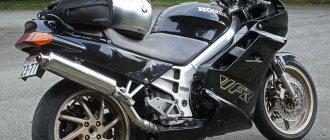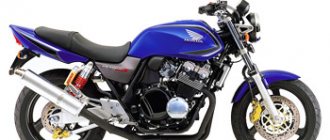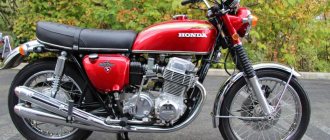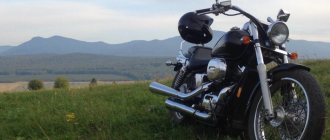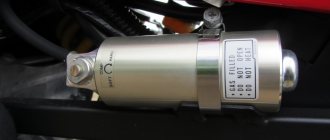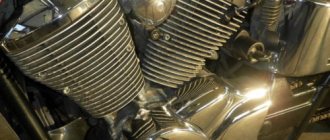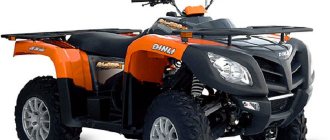Release history
6-speed gearbox, cardan, hydraulic clutch, short chopper frame, forward running boards. During this time, the model undergoes one restyling, but the main features remain recognizable.
The model pleasantly surprises at first glance - unlike many choppers, there is no flashy ostentation here.
In 1993, the third generation of the motorcycle was released, and the first thing to change was the chassis. A chain appears instead of a cardan, 6-speed gears change to 5, and according to user feedback, the brakes have to be modified.
The bike was produced for another 10 years , and in 2003 it was discontinued. The model has no successors, so despite its venerable age it is still in demand.
It is interesting that the export direction of development was reflected in the number of horses , and, accordingly, on all parameters that depend on this. The difference between the Japanese/European and American trim levels is 10 or more horses (the American has more).
text from MotoReview magazine: https://www.motoreview.ru/
This Honda custom is well known to several generations of chopper riders. And all because, firstly, the model is distinguished by a special set of characteristics, and, secondly, its pedigree goes back to 1982, when the very first modification of the Japanese pseudo-dregster was released. Honda Magna 750, 748 cm3, 229 kg, 75 hp, 00-6300
This Honda custom is well known to several generations of chopper riders. And all because, firstly, the model is distinguished by a special set of characteristics, and, secondly, its pedigree goes back to 1982, when the very first modification of the Japanese pseudo-dregster was released. Then the designers decided to move away from the stereotyped copying of the two-wheeled image of the “American Dream” and offered their own vision of the style - they wanted to build a fast, powerful and dynamic custom. Quite an unusual mixture, isn't it?
And the idea was a success! Of course, the “heart” of the car was a derated sportbike (from VFR750) “water” V-twin. To match the “stuffing” they selected a fairly rigid (by the standards of that time) chassis. At the same time, the model turned out to be very stylish in appearance, which immediately affected the rapid growth of its popularity throughout the world. Magna became a kind of representative of the new generation of chopper-shaped cars and for many years occupied a special market and class niche. In fact, it is from this that modern power cruisers originate.
Since then, several generations of this model have seen the light. The last upgrade - in 1993 - can be considered the final “work on the bugs” - the correction of all those shortcomings that had accumulated over the years of production of the old Magnas. There have been a lot of updates, and it’s not surprising that the latest generation of custom is noticeably different from the previous ones.
The appearance has changed - the motorcycle has become even more similar to a dregster. The “stuffing” was also redesigned - the engine was further derated to improve the flexibility of its characteristics, the number of gears was reduced to five, and the power system was modernized.
The model is still produced in this form, which does not prevent it from competing with even the “freshest” choppers. It was this feature that interested us when choosing the next “character” for the “Under the Gun” section. What qualities help Magna still stay afloat? What is its place among modern custom cars? And was it worth the money for which it is offered? Our experts tried to answer these and other questions.
Vladimir Zdorov, Motor Review expert Height - 193 cm, driving experience - 12 years, drives a Suzuki TL1000R I honestly admit - my attitude towards choppers has always been twofold. On the one hand, it’s beautiful: chrome, a couple of centners of iron, a proud landing, an impressive width of the steering wheel. On the other hand, as soon as it came directly to the ride, a wave of deep disgust covered my entire being. “Damn it, how can you drive this!” - a typical train of my thoughts when I was once again trying to squeeze between cars on some terribly fat chopper-shaped one. My surprise was even greater during the test of this Magna. It’s a rare case when the name of a motorcycle accurately conveys its essence. A kind of hot avalanche-like rock...
The car surprised me at first sight. There is no loud ostentation in it, which, sometimes in excess, can be found on other choppers. Everything in the design is aimed at dynamic driving. The landing also evoked a feeling of complete unity with the car. At the same time, all the attributes of style are evident here - the footrests are moved forward, the steering wheel is high, the seat is stepped... But! Everything in moderation, no overdoing. A very good compromise between style and practicality.
The first kilometers of the test took place on the Moscow Ring Road. A good reason to check the maximum dynamic capabilities of the device. The speedometer needle confidently passed the 180 km/h mark, the speed limiter was activated at 190... Well, of course, the model is for the domestic Japanese market. According to my observations, if you remove the electronic bridle, the motorcycle will easily exceed 200 km/h at maximum speed. This is a dynamic custom, and also controllable. Paradox! The combination is as rare as, say, a beautiful Englishwoman who is also a feminist. Yes, of course, after 150 km/h you have to unnaturally bend your neck, trying to take a dwarf pose - it blows away, however! But, dear ones, this is the price to pay for style. If your attitude to dogma is not so radical, in principle, no one bothers you to install a windshield.
However, I digress, it’s time to go to town. At the first junction I go to the side, putting the motorcycle down to the pegs. Amazing stability, not chopper-like at all! Perhaps, in this capacity Magna will give odds even to neoclassics. How does the gearbox work? Once again I am convinced that there is Honda and there are other motorcycles. The suspension is also in perfect harmony with the chassis. On the one hand, there are no annoying dives when braking and endless squats back during more or less serious acceleration. On the other hand, there can be no talk of any rigidity or discomfort when overcoming unevenness.
Potholes and other holes in the asphalt are absorbed perfectly. But there is no perfection in the world. I would have torn off the hands of that cheapskate who decided that one brake disc at the front was enough. Here the engine's capabilities are in clear dissonance with the braking characteristics. The future owner should think about this. Hey, who let that same curmudgeon into the motorcycle transmission? Chain drive? No, this is not correct for custom.
What's the end result? A very stylish and dynamic chopper. There is almost complete harmony. And if someday the editor-in-chief wants to punish your humble servant by putting him on a custom, then I would gladly ride on a Magna. But where did I throw my old biker jacket?..
Denis Panferov (DEAN), independent expert Height - 176 cm, driving experience - 15 years, rides a Honda CBR 1100XX Super Blackbird Here we can list and list... This model is a copy of a motorcycle on a scale of 1:1. A weak plasticine frame that allows the stern to wobble in turns, a flimsy plush rear swingarm that does its best to help the frame. Cloth shock absorbers that do not have rebound damping adjustments and are too soft for aggressive driving. A motor that does not please with either mega-power or mega-torque. A toy torch, driving at night does not inspire heroic deeds.
A small tank that is completely consumed (to zero) in 120 km of fun driving. Can't get up on the rear wheel from the gas, stunted. On the front too - the rubber slides on the asphalt. There is no wind protection - after 140 km/h your back begins to strain, after 160 your arms are already straight, and you hold on to the steering wheel so as not to blow away. The maximum speed is 180 km/h not only due to the limiter, but also due to the power of the engine, which rests its horn on the edge of the great science of aerodynamics. Even with not very strong inclinations, you can reach the asphalt, and if in right turns the folding driver's footrest begins to draw, and this warns, but does not frighten, then in left turns, at the same time as the footrest, the already folded side stand reaches the asphalt, and it is not soft warning contact, but there is a serious danger that after the “teal” there will be a “bang”, because the rear wheel will begin to hang out.
At low speeds (parking, turns in yards, etc.), the motorcycle itself falls inside the turn, and the “90-60-90 women” will break a sweat trying to hold it. The passenger sits on a small “perch” and there is nothing to hold on to other than the driver. In addition, the passenger footrests are located very high. When you press the front brake well, the front wheel skids even on dry, clean asphalt. The “hands shoulder-width apart” pose leads to the fact that they (the arms) become numb after an hour of riding. A soft dermantine saddle without ventilation leads to fogging of the rear (excuse the word “leads”), and this is complicated by the fact that the driver’s footpegs are placed forward, and it is unrealistic to stand on them for ventilation.
You can spit in the face of people who claim that the Magna has an evil Vyfer motor. On the “vyfera” the camshafts are driven by gears (until the 2002 model with flow-through), and on the Magna they are driven by chains, like on one of the most unsuccessful Honda VF750C engines of the early 80s. This is still the same engine, but with the sores of the camshaft play healed. Several years ago, journalists from a respected auto publication got a Lincoln Town Car that was almost twice as long for testing. Well, of course, with a bar, white leather interior, wood trim, music and a partition behind the driver. Complete stuffing like “Hollywood”.
And they, instead of hiring a driver, inviting the girls and having a party on wheels all night, drove it to an icy track to test how IT behaves in a controlled drift. So: the entire first paragraph is a consequence of a similar approach to testing technology.
To enjoy this bike, you need to change your approach. Do not look for an adrenaline generator or sports equipment in the device. This is a chopper. Not a classic, not a custom, but a chopper. And his life passes under the motto “Sign plus 20.” It is with this approach that his entire aura is revealed. In the city at 60-80 it holds a straight line perfectly, easily maneuvers in traffic, the torque in fourth gear is enough to accelerate and get into the opening gaps between cars, worthy brakes, both front single disc and rear drum, even if you press the lever on the steering wheel, when stalled, the front wheel squeals like a victim, but does not lose linearity and directional stability.
On the highway at a speed of 110 (90 allowed plus 20) you can drive 600-700 kilometers without back pain, visiting gas stations every 150 km. The passenger sitting behind warms your lower back and adds stability in corners, adding additional load to the rear wheel. The soft, quiet exhaust does not tire your ears.
When the gas is sharply opened in first gear, it either simply accelerates (if the asphalt is dry), or accelerates, slipping the rear wheel (if the asphalt is wet), but at the same time drives straight. Absolutely predictable and calm. When overbraking at the front, there is no tendency for the fork to fold and instantly fall to the side. In fact, even the least experienced driver will have no trouble driving the Magna. You cannot switch to this motorcycle from a classic, much less from a sportbike. This is the next motorcycle for owners of small-capacity custom bikes. And it steers well, and the power is higher, and it’s not a shame to show off to people. I don’t want one for myself - I’m from the first paragraph...
Alexey Karklinsky, Motor Review expert Height - 182 cm, driving experience - 23 years, rides a BMW R1200 CL Not many motorcycle models have retained their style during their own evolutions. Honda Magna 750 is one such model. And even though adherents of the first version argue until they are hoarse, I like its second evolution much more. Despite its more than long history, this modification still pleases its owners and attracts more and more potential buyers, especially on the Russian market. Surprisingly, rolled examples are rare, which once again confirms the reliability of this model.
What is surprising and pleasing about this motorcycle is the combination of a classic chopper chassis with an unexpectedly “peppy” engine. It’s amazing how it was possible to achieve such a harmonious combination with seemingly incompatible components. Style, fit, exterior - all in favor of leisurely impressiveness. The engine, gearbox, suspension, handling - this is closer to a sports tourer. The tachometer alone is alarming with its immense scale up to 14,000 rpm.
The motorcycle does not immediately reveal its capabilities. It's hard to believe that this Honda does so much more than meets the eye. But facts are stubborn. You begin to enjoy the controllability of the device from the first meters, after a hundred you discover the amazing capabilities of the 75-horsepower engine, after ten kilometers you are almost friends! Enjoy the movement to the fullest. But! The first disadvantage that immediately surfaced was the complete lack of wind protection. With such a landing at a speed of under 200, you won’t last long, even imagining yourself as a “real cowboy.” I didn’t make a reservation, a chopper is a chopper, but if the engine is approaching 10,000 rpm in fifth gear, then the 200 km/h mark is about to come!
The second disadvantage for me was the low-mounted footpegs; when cornering, it’s goodbye heels. And how does this Magna take turns! It’s a pleasure to stick out your knee just right, if only it weren’t for the footrests!
I was surprised by the stability of the motorcycle on any uneven surfaces. Honda is absolutely predictable even on cut asphalt; there is no hint of loss of control during any maneuvers. And the surprisingly low speed of steady movement once again confirms the excellent balance of the entire motorcycle. Ergonomics, as always with Honda, are excellent. We were pleased with the standard mirrors; even with their small size, they provide a comfortable and safe view of the entire rear sector. The switches are usually located with your fingers. Well, the ignition switch above the knee is a tribute to style, without spoiling the impression at all.
A slight criticism was caused by, in my opinion, the remotely located clutch and front brake control handles. By the way, the front brake could be more responsive, and the force is clearly too high, and the feedback (information content) is very conditional. But the rear drum brake is surprisingly effective and predictable, the main thing is the correct adjustment.
I don’t think it’s worth talking about the gearbox - clear and convenient shifting, as on all motorcycles from this company. Well-chosen gear ratios in the gearbox allow you to fully utilize the engine's potential. You just need to get used to his resourcefulness.
When evaluating this motorcycle, you can argue about styles until you are hoarse, but only a stubborn fanatic would not recognize the degree of perfection of this model, and this is at a very respectable age. A novel could be written about the possibility of transformations and tuning for Magna, but let everyone decide for themselves what goals and responsibilities they will assign to their two-wheeled creation. The Honda Magna has character, but let the owners set the accents.
I liked the integrity of this motorcycle, you can just add a little personality, to suit your taste, but take it away - there’s nothing to redo. If possible, I would buy it for myself, for the city, for a lazy summer evening, just for fun. "Magna" is pleasant in all respects.
Mikhail Lapshin, Deputy Editor-in-Chief of Motor Review Height - 192 cm, driving experience - 11 years, drives a Honda CBR 600F Our life is full of surprises. I thought I knew everything or almost everything about choppers, fortunately, I had to ride many. But it turned out that there were gaps in my knowledge. Magna was a big revelation for me.
Here is how it was. With barely concealed melancholy (well, I don’t like custom cars!!!) I walked up to the car, checked the tire pressure, briefly assessed the design (generally stylish, not in the American style), poured gasoline into the tank (it won’t be enough - only 13 liters! )… Well, have you puffed? Then the surprises began. I was struck by the comfortable seating position (even though the footpegs are placed forward, you get on them out of habit with your feet, even if you have previously ridden a road bike), decent handling and engine thrust.
I was expecting juicy “bottoms”, but there weren’t any. But the engine spins superbly, and the sportbike roots are still visible. I won’t say that there is a sufficient number of “horses” here, but this Magna can take off dynamically and confidently accelerate from 100 km/h. There is, of course, no disruption, but there is also no classic chopper thoughtfulness and laziness. The device passes the interval from 0 to 120 km/h “one-two-three”. And here's what's next...
For some reason, the phrase immediately came to my mind - the wind is in my mug, I, hehe, shoot. Let me explain: after 110 km/h, the oncoming air flow begins to pull the pilot out of the saddle. Moreover, if you take into account that you have to sit straight with your arms wide apart and your head held high (the owner of a Magna will always be tormented by pride), it turns out that the wind blower flattens the driver to the fullest. But we accelerate further, fortunately, there is still power in the engine, and, judging by the tachometer, you can still spin the engine indefinitely. 140, 160 km/h... that’s it, I can’t hold my stance anymore.
I try to hunch over, but the oncoming flow is trying to lift my head up more and more. Do I need it? Do I need this maximum speed? And so you can see that the speedometer is graduated to 180 km/h. It is clear that you can do it a little faster, and then the cutoff will work. That's agreed. The Magna isn't comfortable to drive fast unless it's the RS version with the half-fairing.
In general, I went to the city, struggled through traffic jams, got caught in the rain, almost fell apart on wet markings, almost drove into the back of a truck... Everyday life, in a word. But it helps to form an opinion about the car. What happened in the end? The brakes are complete rubbish: not only is there only one disc at the front, but there is also a sluggish drum brake at the rear. The lever does not measure the force well. The chassis is far from perfect. The rear swingarm is somewhat soft, and the frame itself is plasticine.
During normal dynamic driving, which a motorcycle can afford, your arms and back begin to ache. And five gears are clearly not enough. At speeds after 100, every now and then you try to “stick” sixth. This negative is compensated by the excellent performance of the gearbox, excellent ergonomics (visibility in the mirrors is five points!) and handling. The device fits easily on the footrests.
So Magna was the first chopper that I generally liked. But I wouldn't buy it for myself. Firstly, because I am not one of these lovers of two-wheeled pathos. Secondly, I like to drive a little faster. And finally, the cubic capacity will not be enough! But I will always understand the person who discovers this model. Especially if he had experience driving domestic boxer cars or Japanese 400s.
Alexander Dmitriev, editor-in-chief of "Motoreview" Height - 183 cm, driving experience - 15 years, drives a Suzuki SV400, Suzuki DR-Z400 I heard a lot about Magna, rode it a little, but I completely agree with the statement that it is “the only chopper which you can ride." Then fate brought me closer to a motorcycle: I decided to try how it suits every day. Red and bright, the device did not go unnoticed - the security guard at work was terribly surprised at its price of 00. Yes, I say, ten-year old junk... Somehow this definition does not fit with the shiny, fresh chrome motorcycle...
And how did it survive like that? I remember past experiences: on all three Magnas that I tested, the clutch slipped - apparently a typical Magna defect. Here everything is in order with the clutch, so nothing prevented me from driving with full throttle. However, it’s not so simple here: the VFR engine, albeit derated, is oh so good! Although no - a true fan of the American style will certainly be upset by the thrust at low speeds: up to 4000 rpm the engine performs “so-so”. But after that, the acceleration becomes so intense that a beginner gets confused.
I didn’t like the position too much: having ridden a Harley-Davidson V-Rod the week before, I was used to a very good one, and it was difficult to adjust. It seems like a wow landing, but somehow everything is wrong. Maybe my height is too big for Magna? In a word, during the 300 km that I drove, I was unable to sit down with the device.
You don’t have to get used to the controls: you sit down, drive off, accelerate, brake. But the latter was frankly bad: out of habit, I almost rammed my helmet into a truck with a high platform. A trifle, but unpleasant. On the other hand, the device does not have a relaxing effect like other choppers. Accelerates briskly, brakes sluggishly, sometimes dangerously, straightforward...
But, excuse me, what about the handling? Everything is usual here: slight rolls into turns, which, out of habit, if not frightening, then a little surprising, and the difficulty of changing lanes at high speed. However, I never wanted to accelerate faster than 140 km/h.
Specifications
The famous Honda V4 is an extremely reliable, time-tested and polished unit.
As users say, the motorcycle’s power plant is from Vifer. Honda VFR750 sports tourer model.
The bike became the first cruiser to receive a V-shape. The motor turned out to be so successful that they did not reconfigure it. This is a conventional 4-cylinder, 4-stroke liquid-cooled engine.
Users note the use of 95, but at the same time add: “ any, only without sand, the carbs get clogged .”
| Honda Magna 750 | Parameter |
| Motorcycle type | cruiser |
| Year of issue | 1982-2003 |
| Frame | steel tubular |
| engine's type | 4-cylinder, 4-stroke liquid-cooled engine, V-shaped, 748 cm³, 72 hp. |
| Number of valves per cylinder | DOHC, 4 valves per cylinder |
| Fuel supply system | Carburetor |
| Ignition type | CDI - 1982-1986, transistor - 1987-2003 |
| Transmission | 5-speed manual transmission - 1993-2003, 6-speed manual transmission - 1982-1992 |
| type of drive | cardan – 1982-1992, chain – 1993-2003 |
| Maximum speed | 196 km/h |
| Gas tank capacity | 13.0 l – Magna 750 (1987-2003), 14.0 l – Magna 750 (1982-1986) |
| Power reserve | 200 km |
| Motorcycle weight (curb) | 242 kg – Magna 750 (1982-1992), 245 kg – Magna 750 (1993-2003) |
| Acceleration to 100 km/h (0-100 km/h) | 4.3 sec |
| Comfortable cruiser | 120 km/h |
Transmission and clutch
Chain drive – 1993-2003.
Cardan drive – 1982-1992.
The engine is equipped with a 5-speed gearbox (until 1993 - 6 steps ). There were no complaints about the boxes, so this modification only raised questions.
- In models of the first 2 generations : hydraulic clutch, cardan drive.
- The last 10 years have been a cable clutch, and the main drive has been a chain .
Brakes
The generations have not affected the rear drum brake in any way. A motorcycle of any year of manufacture has a standard drum.
Front brakes.
Rear brakes.
But they worked on the front wheel rims at every shift. However, the support in all variations remained the same - a hydraulic bracket with 2 pistons .
- 1982-1987 - 275 mm, 2 disks;
- 1987-1993 - 275 mm, 1 disc;
- 1993-2003 - 315 mm, 1 disk.
No additional systems such as ABS were provided.
Brief history of the model
1982 - start of production and sales of the model. First generation. Model: Honda VF750 Magna (Europe, North America, Japan). Factory designation: VF750CC.
1983 - no significant changes. Model: Honda VF750 Magna (Europe, North America, Japan). Factory designation: VF750C.
1984 - no significant changes. Model: Honda VF750 Magna (Europe, North America, Japan). Factory designation: VF750CE.
1985 - no significant changes. Model: Honda VF750 Magna (Europe, North America, Japan). Factory designation: VF750CF.
1986 - no significant changes. Model: Honda VF750 Magna (Europe, North America, Japan). Factory designation: VF750CG.
1987 - restyling of the model. Second generation. The model gets a new appearance, a single-disc front brake, a new front fork without anti-dive, a new wheel size, a 13-liter fuel tank, and increased maximum power (77 hp for Japanese versions). Model: Honda VF750 Magna (Europe, North America, Japan). Factory designation: VF750CH.
1988 - no significant changes. Model: Honda VF750 Magna (Europe, North America, Japan). Factory designation: VF750CJ.
1989-1992 - the model is not produced. 1993 - restyling of the model. Third generation. The model gets a new appearance, a new wheel size, a cable clutch (instead of a hydraulic one), a chain drive (instead of a cardan drive), a new cartridge telescopic fork, new carburetors and a new engine (the timing system has been changed, the compression ratio has been increased to 10.5). Maximum power is 75 hp. (Japanese versions). The gearbox becomes a 5-speed with new gear ratios. Model: Honda VF750 Magna (Europe, North America, Japan). Factory designation: VF750CP.
1994 - no significant changes. Model: Honda VF750 Magna (Europe, North America, Japan). Factory designation: VF750CR.
1995 - no significant changes. Model: Honda VF750 Magna (Europe, North America, Japan). Factory designation: VF750CS.
1996 - no significant changes. Model: Honda VF750 Magna (Europe, North America, Japan). Factory designation: VF750CT.
1997 - no significant changes. Model: Honda VF750 Magna (Europe, North America, Japan). Factory designation: VF750CV.
1998 - no significant changes. Model: Honda VF750 Magna (Europe, North America, Japan). Factory designation: VF750CW.
1999 - no significant changes. Model: Honda VF750 Magna (Europe, North America, Japan). Factory designation: VF750CX.
2000 - no significant changes. Model: Honda VF750 Magna (Europe, North America, Japan). Factory designation: VF750CY.
2001 - no significant changes. Model: Honda VF750 Magna (Europe, North America, Japan). Factory designation: VF750C1.
2002 - no significant changes. Model: Honda VF750 Magna (Europe, North America, Japan). Factory designation: VF750C2.
2003 is the last year of production. Model: Honda VF750 Magna (Europe, North America, Japan). Factory designation: VF750C3.
Driving characteristics (dynamics, acceleration)
A sufficient number of horses under the tank of the motorcycle allows you to move off dynamically and confidently accelerate from 100 km/h.
According to the developer's specifications, the maximum speed is 196 km/h . The owners note that at 160 km/h the wind begins to blow, but the power reserve is felt, so 190 is quite possible. Therefore, a comfortable cruiser is 120 km/h .
Acceleration from zero to 100 km/h in 4.3 seconds . According to user reviews, if we do not forget that this is a cruiser, for which sedate, leisurely driving is considered more normal, the performance is beyond praise.
Fuel consumption
According to the manufacturer's documentation, consumption is 2.63 to 4.52 liters per 100 km. But these are Japanese data. Owners in the Russian Federation note that you are unlikely to see anything below 5 liters. And if you anneal it, then all 10 liters .
The final result depends on your riding style. 13 liter tank means a mileage of no more than 200 km on one fill-up .
Review of the Honda VF 750 Magna (V45) motorcycle
I opened category A and started the new season with a Magna V45, brought with a mileage of 5000 km from Japan. I took a chopper-shaped motorcycle with the expectation that it would not provoke dangerous maneuvers and because I love beautiful equipment... The engine is a V-shaped 4-cylinder, with a volume of 750 cubic meters, 77 horsepower (for America they were more powerful - 88 horses !). Basically, it's a dragster. A kind of lean chopper with an engine from the sport-tourist Vifer. The drive to the wheel is via a cardan. According to the manual, maintenance is done every 15 thousand, in practice I change it more often. Cooling is liquid. I use 95 gasoline. And it eats well; if you drive fast, it can consume 10 per hundred, especially after installing a jet kit in the carbs (and there are 4 of them), which increases the torque at the bottom. Now the rpm can be kept about 1000 less. (maximum revolutions - 10 thousand, pulls normally from 3 thousand, main operating speeds - 4.5-7 thousand revolutions) Tank - 13 liters. Yes, the gearbox is naturally manual, 6-speed. I had little experience driving a manual, so I had to get used to it. But on a motorcycle, mechanics are a blessing, because... it does not interfere due to the fact that the motorcycle is not stuck in traffic jams, but the absence of unexpected switches in a turn is very desirable.
By itself, my motorcycle is low and long, so it doesn’t rear up on its own (although a professional in his field will probably bully it), and if on cold tires I overdo it with gas or just suddenly release the clutch, it leaves black stripes and grinds the asphalt with the wheel.
Thanks to the motorcycle, I was able to go to work while living in the country. In the morning traffic jams, along the Minsk highway, I got to the very center in an average of an hour or an hour or 10... The same way back. And this is 90 km one way.
It’s just hard to describe how great it is to be transported from hot, stuffy Moscow to nature in an hour and have dinner at a table in the garden, listening to birds singing and throwing pine cones into the samovar... I just got there by car - I need to go straight to sleep... It’s long and hard.
Among the breakdowns, the carbs began to become clogged, either they put gasoline and sand in my tank, or the tank began to rust, but the needles sank and the carbs were flooded. As a result, after disassembling and cleaning the carbs, a gas filter was installed and the problem disappeared. There is a stupid story connected with this. On an empty road near Moscow, going from Kubinka to Zvenigorod, the needle in my carburetor apparently got stuck and the carbs were flooded. After suffering for some time this way and that, pouring gasoline from the carburetors, the engine was brought back to life, but the smoke was pouring out thick and white, like from an IZH. I jumped into the saddle and let him “shit” to the fullest. Everything unnecessary was burned out, the smoke disappeared and suddenly the motorcycle stalled... I stopped in complete disarray on the side of the road and began to think what to do, since I assumed that the carbs were to blame again... Luckily for me, guys were riding from the bike rally on choppers, who, like As is common among normal motorcyclists, they stopped and together with me began to look for a solution to the problem... When it turned out that I had simply run out of gas, I just felt like a complete idiot!! In general, everyone poured gasoline for me from their tanks and I was able to continue my journey. Guys, if you are reading this, THANK YOU again!
I bought my Magna completely by accident. Initially I wanted to take an old Golda, but her owner never deigned to bring her back to normal, and I made an advance payment back in February. In April, I accidentally saw a motorcycle in a service center in the same form - the frame was under the wall, the engine was lying nearby, all the accessories were on the shelves and corners. And then the season opened and we had to figure something out quickly. A friend of mine just brought motorcycles for sale and I went to look. Among the motorcycles that arrived to him was a black Magna vf750, produced in 2001 with 89 horses. The motorcycle looked quite attractive, it had new tires, all the consumables were changed (they were changed at my request), the chrome was corroded by rust in some places, but everything else was in order and worked. I decided to take it, until that moment I had only driven sports - before Magna I was running around on a 919 razor.
The first impressions made me very happy - the motorcycle handled very well. Handling is classic. The center of gravity is low, the front wheel is not very far forward, which makes the motorcycle nimble; in general, it is very comfortable to ride in the city. The bike copes with traffic jams no worse than sports. There are no brakes. After the reinforced hoses were installed, the situation improved a little. The advantage is that you can ride safely and not be afraid of the front wheel slipping. In choppers, when the front wheel falls off on a straight line, Magna stupidly continues to slide forward. In short, some kind of attraction. After sports, such things are very relaxing, you won’t get that high there. Here, even in a turn, breaking the front does not threaten you with a fall, the main thing is not to get too full.
As for the seating position, it is comfortable, the saddle is comfortable, but the pegs with a specific forward reach bothered me quite a lot. In principle, I don’t like the choppy position, it’s completely unnatural, plus it severely limits movement, which is not good when driving a motorcycle. It is not very convenient to change gears with your leg extended forward - sport or classic in this sense are much more convenient. It is generally impossible to stand up on the steps, and therefore, moving over potholes and bumps, even small ones, causes pain in the spine. Such a motorcycle is completely unsuitable for long-distance driving - it is purely urban transport.
The engine is a good 750 cc, exactly like the one on the old Vyfer. It starts a little sluggishly, I was really a little spoiled by the more powerful engine. Basically, this is an ideal engine for beginners. It drives the same in any gear, not capricious and reliable - what more do you need?
Having driven the bike into my garage, I cleaned all the rust from the chrome, changed the oil in the fork - I filled it with a harder one, replaced the handles on the steering wheel - I installed ones that were comfortable for me. I also wanted to screw on the back and glass, but a friend really liked the bike, so before I had time to do this, he took it for himself and drove it for three seasons, of course.
Now, I almost forgot, there’s almost no light, there’s a tiny headlight, so why the hell change this kind of equipment for something more sensible. Okay, no problem with that now. The fuel gauge is also missing - instead there is a small light bulb. The tank is small, but this compensates for the moderate fuel consumption.
In general, the motorcycle is very beautiful, there is some kind of zest in it, or something. Good for beginners, even suitable for a girl, due to its low seating and ease of control.
I've been riding a Magna for the 3rd season. Well, what can I say... In terms of dynamics and power, it easily tears up any chopper-liter (and even more!) Provokes unscrewing. Good weight - not big and not small. Steering is not bad. (relative to other chopper-like ones) The seating position is quite comfortable -closer to the classic. (you can stand up on the steps on the pits) These are advantages. Of the disadvantages: a child’s tank (boils) and not a child’s appetite (if you fry it). Chain (universal shaft, of course, less gimmorous) The layout is dense (4 kule boilers...) Brakes (or rather the lack thereof) But... For me, Magna is like a beloved woman! You know all the shortcomings, but you forget about them in bed (on the road) where she is a HURRICANE!!! In general, I love her!!!
I'm not going to change this pepelats yet. Last season I installed roll bars, 70-liter panniers and a windshield. For this season, I boiled the tank down to 22 liters and installed a reinforced hose on the front brake. Happy as an elephant))). Now we need to come up with something with the rear shock absorbers, because... They have a very short stroke and sometimes leak when fully loaded. In general, only positive impressions. A very reliable device that can be used as a cruiser. I really like the handling, it handles almost like a classic! No breakdowns were noted.
Modifications
No official modifications were made based on the motorcycle. But if you remember the third generation, which completely changed the chassis, it can be considered a variation.
Over the many years of production, the motorcycle changed colors several times.
and competitors
Despite the fact that the Honda model has long been considered a standard cruiser, competitors failed .
Only Yamaha . Its road bike FZX 750 , born in 1986, nicknamed outside Japan “the first Fazer” (the legendary liter would be born only 15 years later), could in many ways compete with Honda’s cruiser, but could not become a full-fledged replacement.
Features (advantages and disadvantages)
The motorcycle frame is made extremely well for a model of its time.
After replacing the chassis, even the developers could not name any special differences in their model.
- 2 springs on the rear shock absorber.
- Short working stroke of the suspensions - with a heavy load you can break through even a slight unevenness.
- The long wheelbase gives stability and protects the novice pilot from mistakes.
- The average fork offset does not interfere with handling.
- The low center of gravity makes it possible to actively maneuver without fear of “decaying”.
- Despite its choppy appearance and size, it’s good for traffic jams.
- The light is, according to some reviews, downright weak.
- The chopper offers a classic riding position, and forward-mounted footpegs allow you to change your position, which is quite problematic on a regular bike.
Sometimes there is a big appetite and a small tank , but this motorcycle is not intended for racers.
Design Features
The Honda Magna 750 motorcycle is the perfect combination of appearance and a powerful engine, the result of which is a maximum speed of 195 km/h with a curb weight of 236 kg. The first hundred was reached in just 4.3 seconds, which is considered an incredible indicator for a cruiser. Such a motorcycle could even outrun some sports models from a standstill, which was also helped by a comfortable 6-speed gearbox. With such high-speed characteristics, the motorcycle is suitable only for experienced bikers, because controlling such a beast will be extremely difficult.
This motorcycle went through three modernizations, the second one began to be produced in 1987. Then the appearance was slightly changed, the overall silhouette became more beautiful and expressive. Unfortunately, it was decided to remove the second disc brake from the front wheel. The most successful was the third generation version, which received a chain drive, a more durable and comfortable frame, as well as a new fuel system. The carburetors have been completely updated and brought to perfection. As a result, it is better to buy a Honda Magna 750 in the latest version; today it is represented by many copies. Also among the improvements of the third generation is the appearance of a new telescopic fork. New improvements to the latest modification have affected the total weight of the motorcycle, now it is 244 kg. But even this figure is not considered high for the Honda Magna 750; reviews regarding handling and dynamics are only positive.
The motorcycle will be an excellent assistant on long trips, but when buying such a motorcycle, you should be prepared for additional expenses on maintenance and travel.
In particular, be prepared for fuel consumption per 100 km to be 8.2 liters. Although at this price of the motorcycle, owners should not worry too much about consumption.
